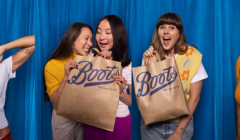
Boots captures the joy of saving
The Savvy Savers campaign features Boots shoppers celebrating the savings they’ve made.

Valentine's Day has historically focused on a one dimensional view of love that excludes the majority

Valentine's Day. A day that historically celebrates and validates a one dimensional view of love. An archetype of romance which is anything but inclusive. Celebrating romantic love, all too often between a man and a woman, primarily through purchasing gifts, in many ways feels out of touch with the reality of multifaceted lives in which ‘romantic love’ is not the pinnacle of a patriarchal achievement economy.
With the stigma around being ‘single’ failing to reflect the reality of choice, the plethora of cards featuring imaging heterosexual couples adds to the sharp edges of a ‘celebration’ which in many ways must belong to a bygone era.
Yet while the mass market mainstream Valentine’s marketing machine might favour romantic love above all else, many have already co-opted Valentine’s for their own ends. From parents choosing Valentine’s Day as a moment to mark their love for their children, to the growing popularity of ‘Galentine’s Day’ a special day dedicated to honouring friendship in all its forms.
So can marketers also embrace the power of doing Valentine’s Day differently, or is it time to call time on idealising romantic love above all else? For a toxic tradition designed to sell an outdated, idealised and one dimensional view of love is anything but inclusive. With this in mind, we asked industry leaders if Valentine’s Day can ever be an inclusive marketing opportunity?

Contrasting with the high-emotion ads we see at Christmas, Valentine’s Day activity is commercial without fanfare, asking us to buy stuff and book dates. Even as a queer person holding a less traditional view of romance, I don’t feel it needs to represent much more than this.
Underwear and adult brands approach the day without pretension, and they’ve made some interesting choices this year: Bluebella’s face is Rebecca Lucy Taylor (Self Esteem), proudly bisexual and known for her hyper-honest writing on love and sex; Skims features Simona Tabasco and Beatrice Granno, known for playing happy-go-lucky sex workers in White Lotus; at Coco De Mer, Charli Howard is unretouched in a lingerie shoot, part of a wider ambassadorship benefiting #EndFGM.
Approaching Valentine’s Day through sex, with simple imagery and a message, revels in the aesthetic of the holiday without alienating any type of relationship. Single, monogamous, polyamorous consumers of all sexualities can find relevance. Although they're not explored in great depth, there are important messages inferred: sexuality is a part of life we shouldn’t be ashamed of; sex work is work; women’s pleasure is important; all body types are beautiful. In the future, we can see these issues backed up with better cast diversity in terms of race, body type and gender identity to show that we can all enjoy Valentine's Day for exactly what it is.

Valentine’s Day is a little bit ridiculous. Saint Valentine, the day’s namesake had very little to do with romantic love, and his cause was hijacked by the idea of romantic love in the 18th Century. Unsurprisingly, those hugely commercial Victorians were big for it; and from there on in cards and other such tokens of affection have been flogged to consumers around the world. Ching-ching!
If we took it seriously, then the day could be seen as pretty toxic, largely championing completely unrealistic heterosexual romantic love. Pretty crappy if you are in a heterosexual relationship because hopefully you feel loved a little more than once a year (and being given a gift which verges on tacky and impersonal is actually pretty unloving). And even more crappy if you’re single or if your choice of how and who you love is excluded.
However, to completely ignore Valentine’s Day feels a little bit unnecessary. It’s going to happen so marketers and advertisers might as well use it and this can be done in two ways. The serious route is to right the ridiculous Valentine's Day wrongs - stand for love in all its forms and expressions. However, this route relies on sincerity and if your brand can’t be credible then there’s always a second route: have some fun with it. Snicker’s You’re forgetful when you’re hungry campaign which gave forgetful lovers a last minute Valentine’s Day card, and the Moonpig and KFC collaboration to create fried chicken scratch and sniff Valentine’s Day cards (because apparently nothing says romance like the smell of fried chicken) are both great examples of this.

My Funny Valentine? Oh wait … it’s ME!
In an age of empowering friendships over relationships and non-trad couplings – the heart-holding-teddy Valentine image is long outdated. Vice Media research finds that just one 1 in 10 Gen Z’s are “committed to being committed”. Even dating apps like Hinge are shaping the elusive romantic dream by homing in on ‘long term connections’ as the next gen seek personal growth over finding ‘the one’. So, when we think ‘Valentines’ what should we be emotionally connecting with? Valentines has already been transformed into next chapter experiences but is there a missing opportunity for brands to bond with every individual in a more personal way, that can mean much more? In a post-covid 2023 you can book a Valentine baking weekend, bottomless brunch, and GloryHoles cheeky adult mini golf… with your OH, LGBTQ+ crew or mates. Yet the continuing rise of self-love signals an era where outdated romance modes are not the ultimate win in life. Brands re-thinking Valentines as a way of being and living, helping to facilitate loyalty to oneself is the next love revolution. After all, as RuPaul puts it “if you can’t love yourself how in the hell you gonna love someone else”.
Looks like you need to create a Creativebrief account to perform this action.
Create account Sign inLooks like you need to create a Creativebrief account to perform this action.
Create account Sign in